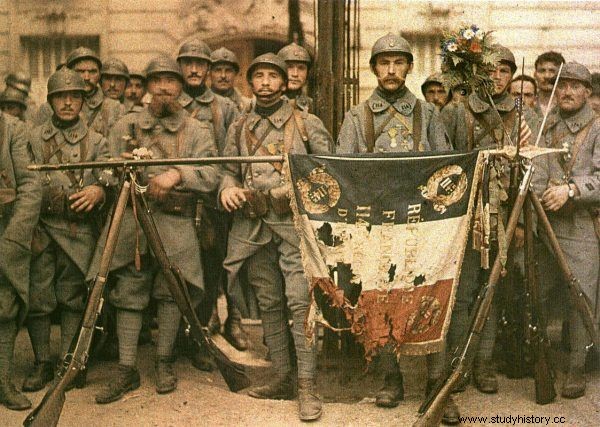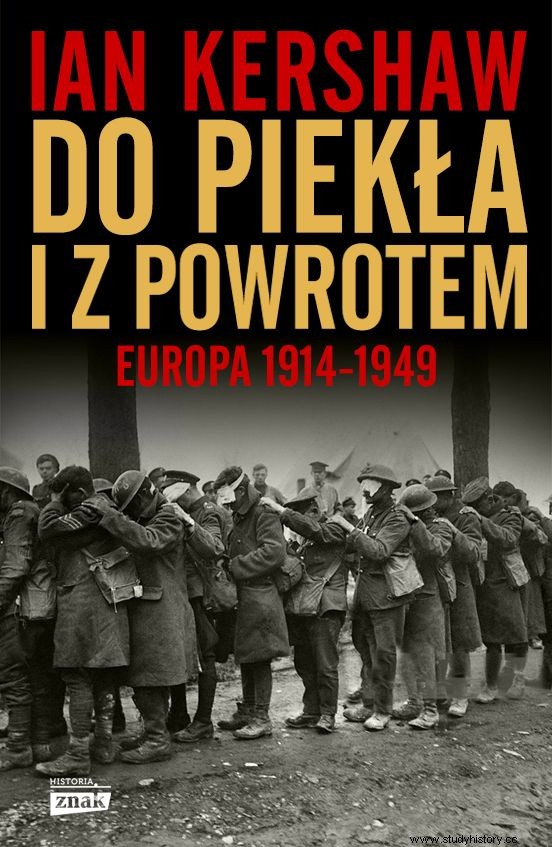More than 9 million soldiers killed. Another 15 million wounded and sick. This is the murderous balance sheet of the Great War. We present the bloodiest clashes in the conflict that lasted more than four years.
Machine guns, sniper rifles, guns and mortars of various calibers, mines and mine throwers, shrapnel, grenades, aerial bombs, flame throwers, lethal war gases, armored cars, tanks, planes firing from the sky, bombing or directing artillery fire ... One hundred years ago modern weapons, used in great numbers, inflicted death:impersonal and absolute, on an unprecedented scale - writes Ian Kershaw in "To Hell and Back" .
Modernity, however, has not removed tools with a pedigree of several hundred years:cavalry lances, sabers, bayonets, and even special assault maces or steel darts dropped from airplanes. These were still effective. The soldiers of practically all armies faced other dangers - diseases, wound infections, and in mountainous conditions also frost, snow and avalanches.
Victims are invalid. Only the victory counts
For emperors, kings, and presidents, all that mattered was victory. Accordingly, their generals, as Kershaw noted, are already p while planning offensive actions (...) they started taking into account the great loss of life. Perhaps it was on them that the creators of the film "Shrek" depicted the power-hungry Lord Farquaad, who, encouraging his knights to travel and fight the dragon, said: Probably many of you will die, but this is a sacrifice I am ready for.

For the leaders of countries fighting in World War I, the lives of soldiers did not matter in the slightest. Only victory mattered. (Photo:Léon Gimpel; Lic. Public Domain).
In the years 1914-1918, orders sentenced to death, wounds or disability a total of over 20 million soldiers. Verdun, Somma, Ypres, Arras, Passchendaele, Gallipoli, Galicia, or the Carpathians are the names of places where the military blood of both sides of the conflict was shed in abundance. The millions of men who were sent there a century ago never returned home. In most cases, their deaths did not bring any, even illusory, military benefit.
Trench Hell
The first serious losses in those killed, wounded, missing and captured took place at the beginning of the war, when the Germans, rejected from Paris, lost around 680,000 and the Allies - the French, British and Belgians - about a million soldiers. Both sides then descended into trenches and field fortifications, which were extended to the size of enormous labyrinths stretching from the shores of the English Channel to Switzerland.
Though the fortifications provided cover and defense, they were full of fleas, lice, and rats, as well as damp, water, mud, dirt, and the stench of human excrement and rotting unburied bodies lying in no man's-land. From time to time, enemy artillery shells fell there. Leaning over the cover there was a risk of being shot by a sharpshooter, and in addition, you had to constantly be on your guard, because during the day there was a threat of an assault, and at night - a secret attack of small enemy assault groups.
Blood Bath in the East
It was a little better in the East. This front could not be as tightly secured with trenches and wire entanglements as in the West, but the fighting was just as bloody. In the summer near Tannenberg and the Masurian Lakes, and then in the winter in Masuria, the Russians lost almost 300,000 soldiers .

German propaganda boasted that a rematch had been taken for the Battle of Grunwald. Let it be. After all, at Grunwald, it was the Poles who defeated the Teutonic Knights together with the Lithuanians, and their successors 500 years later took revenge on the Russians.
The "Russian roller" achieved more success in Galicia, where it reached the Carpathians in the south and Krakow in the west. During the winter fights in the Carpathians, the snow reached 2.5 meters in height, the temperature dropped to -30 degrees, the wounded in no-man's-land were bitten by wolves, and historians calculated that during the Carpathian campaign, the statistical c.k. the soldier fought for 5-6 weeks.
After this period, he was dead, wounded, sick, unable to fight because of frostbite or in captivity. At the turn of 1914 and 1915 in the Carpathians, Austria-Hungary lost a total of 800,000 soldiers and earlier in the fights in Galicia almost a million . It was no better on the Russian side. Several hundred soldiers passed through my platoon alone. At least half of them ended up in various battlefields. They died or suffered wounds that made it impossible to continue fighting - noted the Russian officer.
The battles in the East were resolved by the Battle of Gorlice on May 2-6, 1915. The Russians lost 100-150 thousand soldiers there and by October, the Kingdom of Poland, Lithuania, almost all of Galicia, almost 2 million soldiers and they had to go back about 500 kilometers.

Only in the first months of the war, the Russians lost nearly 300,000 soldiers in the fight against the Germans. The picture shows a German postcard issued on the occasion of the victory at Tannenberg (source:public domain).
In the West, this trick was unsuccessful, and blood was shed profusely. The sounds of officer whistles or trumpets signaling the attack were heralds of death in the crossfire of machine guns.
Unprecedented slaughter in the West
So other ways were tried. In April 1915, the Germans used poisonous gases near Langemarck near Ypres. Hundreds of soldiers fell into a death coma - recalled a British officer. Another added: The worst thing is that the victims are doomed to slow death. I have seen hundreds of sufferers and the doctors were helpless . Chemistry took the lives of thousands of enemies, but the fate of the war did not change.
The Allies also failed to eliminate Turkey from the war. The landing at Gallipoli was successful, but due to the mistakes of the commanders it ended in a trench warfare on the bridgeheads. In January 1916, the Allies withdrew, having lost almost 270,000 soldiers by then. . The defenders included 220,000 victims .
In 1916, further attempts were made to settle the matter. Slaughterhouse - that's what we need. A place that will become a slaughterhouse for the French - German staff officers explained the idea, planning to concentrate their forces in one place and bleed the French out there.

German soldiers during one of the bloody storms at Verdun (source:public domain).
In February, they attacked the fortified Verdun. I don't think you can imagine this horror. Nobody can do it if they haven't experienced it for themselves - wrote a German soldier quoted in Ian Kershaw's book. The fights lasted until December, and the "slaughterhouse" that was set up noblew both sides. The French lost a total of 377,000 soldiers , and Germany - 337,000. Frontline changes were minimal.
In July, the British attacked the Somme. After a week of artillery preparation, the assault was launched, but the artillery did not destroy either the German fortifications, or even the barbed wire. On the first day alone, the British lost a total of almost 57 and a half thousand people - setting the infamous daily record of losses in the royal army, because the staff at the rear were convinced of the effectiveness of the firing and deprived of observation of the battlefield, they sent more groups to attack.
When we returned, there was no customary roll-call, because out of eight hundred [sic!] there were only twenty-five of us left. There was no one to count - that day was recalled by a British soldier whose account is quoted by Kershaw. The fighting ended in November - the Allies advanced 10 kilometers for the cost of 625,000 soldiers , The Germans lost 465,000 people.
Two million in the East. No changes in the West
In June in Volhynia, the attack was launched by the Russian troops and initially pushed forward, but then they got stuck. Profit - shifting the front 90 km to the west. Costs - one million Russian soldiers lost . The Germans and the Austrians suffered similarly heavy losses.

The seizure of Passchendaele cost the lives of 400,000 British and 236,000 German soldiers (photo:John Warwick Brooke; public domain license).
In 1917 it was just as bloody. Mainly the Allies attacked. At Arras, they moved the front a few kilometers, for a total cost of 150,000 soldiers when the Germans lost 100,000 . In the summer they made an attempt to conquer the Belgian village of Passchendaele. After 3 months of an offensive in sticky mud full of craters from deep-water missile explosions in which thousands of soldiers drowned, they took it.
Price for planting a banner among the ruins of country houses: 400,000 soldiers for the British and 236,000 for the Germans . In November, the attack took place at Cambrai. The Allies advanced seven kilometers. The attackers and defenders lost a total of more than 85,000 soldiers .
After the Bolshevik Revolution and the conclusion of peace with Russia, the Germans managed to transfer some of their forces to the West and made an attempt to break the front before American troops entered the fight. In March 1918, they attacked the Somme. On the first day of the offensive, the Germans and the Allies lost about 40,000 people each .

It was the bloodiest day of the war and another infamous record, this time of losses on both sides together. Hell continues a British officer wrote. By the time it was over, the Allies had lost nearly 340,000 people and the Germans, who moved the front 65 kilometers - almost 240,000 .
A sea of shed blood
Much blood was also shed during fights on the Italian front, including in extreme alpine conditions, during fights at sea and in the air. The ships hit frequently exploded and drowned with entire crews, and the heroes of the skies had unarmored cabins, technically imperfect or poorly made machines, and - in order to "encourage combat" - the use of parachutes was prohibited.
The slaughter on the continent did not end until the armistice on November 11, 1918 at 11 a.m. By that time, more than 9 million soldiers had died or died of diseases and wounds - every sixth French, every seventh German, every eighth British, every ninth Russian . 15 million soldiers were injured or fell ill. Several million have had to live physically or mentally crippled.

On November 11, 1918, the Armistice of Compiègne was signed, which ended the horrors of the Great War. Before this happened, however, about 9 million soldiers lost their lives (source:public domain).
Even the "savages" from Oceania, on which Polish anthropologist Bronisław Malinowski conducted research, were shocked by the war losses:
One time I was talking to an old man-eater who, hearing about the great war raging in Europe, wondered if Europeans could eat so much human flesh. When I told him that Europeans do not eat killed enemies, he was very shocked and asked if we were such barbarians as to kill aimlessly.
***
Most of the death tolls are in line with Ian Kershaw's book, To Hell and Back. Europe 1914-1949 ”.
